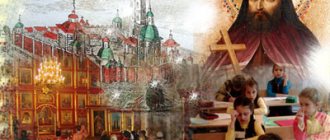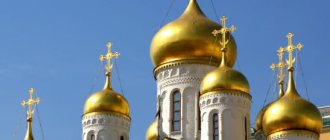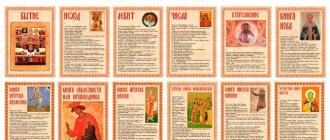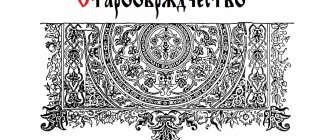At the turn of the 15th-16th centuries, serious problems arose in Russian Orthodoxy, which resulted in a confrontation between two religious and political groups, known under the names “non-covetous” and “Josephites.”
Between representatives of these branches of Russian Orthodoxy, a tough half-century discussion broke out about the right of monastics to own land and property in general, as well as about ways to combat heretics, of which there were more and more in Russia.
Dates, causes and consequences of occurrence
1479 – Joseph Volotsky founded his own Joseph-Volokolamsk monastery. The abbot received monks from other monasteries into his monastery. He also received the hungry, giving them bread. This same monastery was the starting point for future Josephites.
The reasons for the emergence of the church-political movement of the Josephites are two main factors:
- The emergence of the Judaizer heresy in Novgorod in 1470;
- The desire of Tsar Ivan III to limit or completely eliminate church land ownership.
The consequence of the struggle of the Josephites with the heretics (Judaizers) was the convening of the Council in 1504, where they were cursed (anathematized).
In the same 1504, at the Council, Ivan III Vasilyevich changed his point of view and supported the Josephites.
Activities of the Josephites
The activities of the followers of St. Joseph were carried out in several directions. The main directions were the following:
- As abbots they served in the monastery of the Monastery of St. Joseph;
- They were abbots in a number of large Russian monasteries;
- They worked in the bishop's departments.
The internal routine of the Joseph-Volokolamsk Monastery was aimed at order and unity among the monks. All this, along with high standards of teaching, as well as corporate solidarity, contributed to the fact that people from this monastery, who occupied high spiritual positions, actively promoted graduates of the Joseph-Volokolamsk Monastery.
In the second half of the 16th century, the monastery took 19th place in terms of influence in Rus', according to the “Ladder of Spiritual Authorities”. Josephite abbots played an important role in church and zemstvo councils.
Examples:
- 1566 - signing, among other clergy, by Abbot Lawrence of a conciliar verdict on the continuation of the Livonian War;
- 1587 - Abbot Levkiy, among others, signed a letter of ascension to the throne of Boris Godunov;
- 1613 - Hegumen Arseny, among others, signed a letter of ascension to the throne of Mikhail Fedorovich Romanov.
The monastic monastery monastery's monks were frequent guests at the residence of the Tsar, as well as John IV Vasilyevich during his military campaigns.
According to the 1522 charter of Vasily III Ioannovich, matters related to the Joseph-Volokolamsk Monastery could be judged exclusively by the Grand Duke. This decree was canceled by Stoglav in 1551.
The charter of 1556 indicates that jurisdiction now belongs to the Volokolamsk brethren to the Moscow Metropolitan, His Holiness Macarius. In 1563 to the Archbishop of Novgorod. In 1578 to the royal court.
Throughout the 16th century, state authorities and the church sought to make studying at the Joseph-Volokolamsk Monastery a mandatory career step to the rank of abbot and archimandrite in many Russian monasteries.
The Josephites reached their highest point of influence in the period from 1542 to 1563. At this time, the position of metropolitan was held by Macarius, who revered the Monk Joseph of Volotsk.
By 1551, when the Council of the Hundred Heads was convened, people from the Joseph-Volokolamsk Monastery occupied 5 of the 10 posts of bishops' departments.
Historical reference
Since the time of Epiphany, there have been no serious religious conflicts in Rus', much less repressions based on faith. If the Inquisition was raging in the West, Europe was torn apart by wars between Catholics and Protestants, then Rus', Kiev, and then Moscow, remained undividedly devoted to the Orthodox Church.
And yet, although the basic dogmas of Orthodoxy remained unshakable, in the second half of the 15th century an internal church split emerged in Russia.
Occurrence of movements
The dispute between two currents of Russian Orthodoxy, which began at the end of the 15th century, took place against the backdrop of the country’s successes in both foreign and domestic politics.
In 1480, Grand Duke Ivan III achieved legal independence from the Golden Horde, which at that time was breaking up into separate khanates.
At the same time, the process of unifying the lands of Rus' under the hand of Moscow was in full swing:
- rebellious Tver, freedom-loving Novgorod and other principalities joined;
- part of the original Russian lands captured by Lithuania came under the jurisdiction of Moscow.
After the fall of Byzantium, Muscovite Rus' became the only sovereign country in which Orthodoxy was practiced. Princess Sophia Palaeologus brought a new coat of arms to Rus' - the Byzantine double-headed eagle, and society gradually began to form the belief that the Russian prince was the heir to the monarch of Byzantium, and Moscow, as the only guardian and defender of Orthodoxy, was the “Third Rome”.
From the title “tsar,” which at that time often began to refer to the ruler of Rus', and the acquisition of a coat of arms, it did not follow that Rus' inherited all the principles of the state and spiritual structure of the Byzantine Empire. But Orthodoxy, which came from Constantinople, became a unifying, truly Russian force in the soul of the people.
It allowed:
- reject the Florentine Union with Catholics;
- depose her supporter, Metropolitan Isidore;
- in 1448, elect the first Russian metropolitan to the throne as the head of the Church.
Thus, the Russian Church ceased to depend on anyone, even on the “cradle of Orthodoxy,” and the princes gained great influence in it.
The remnants of paganism that still persisted in Rus' were subjected to a decisive attack by the Church, as well as the heresies that had penetrated into Rus'. Basically they talked about the Bogomil heresy of the “Strigolniks” and the heresy of the “Judaizers” that came with the Lithuanian Jews.
It was on the issue of the fight against heretics, or more precisely, on punishments for them, that the “Trans-Volga elders” and the Josephites subsequently sharply disagreed.
Under these conditions, within the Church itself, the prerequisites appeared for the emergence of a discussion around spiritual and moral problems, which took shape in a confrontation between two groups. Their leaders, the Venerable Joseph of Volotsky and Nil Sorsky with their adherents, did not fight with each other in any way, their disputes did not lead to schism, and the polemics were constructive and concerned only with finding a way to develop priorities in relation to new political and spiritual realities.
Development and distribution
Secular authorities, of course, did not avoid the discussion. The lands of Rus' at that time were not so large, it was not possible to provide all service people with worthy estates, so Ivan III initially took the position of non-covetous people who agreed to place monastic lands at the disposal of the state.
But at this time it became clear that more and more officials were joining the heresy of the “Judaizers,” and the prince, as a guarantor of the purity of the faith, moved to the camp of the Josephites.
The serious illness that struck down the Grand Duke in 1500 also played into their hands, because the co-ruler and heir, Prince Vasily, was the spiritual son of Joseph of Volotsk and completely fell under his influence. Largely due to these circumstances, at the Council of Bishops, which discussed the problem of heretics, it was decided to organize its own inquisition in Rus' and send “Judaizers” and other heretics to the stake.
This was a defeat for the non-covetous, who called for action by persuasion and not by fire.
Subsequently, the “Trans-Volga elders” incurred the wrath of the grand duke twice more. Vasily III, who took the throne after the death of his father, was childless and blamed his wife, Solomonia Saburova, for this. Having imprisoned her in a monastery, he obtained a divorce and married Elena Glinskaya, the future mother of Ivan the Terrible.
Monk Vassian, in the world - Prince Patrikeev, at that time the most prominent representative of non-covetous people, openly accused the prince of deviating from the canons of Christianity, which prohibited divorce. Then Vasily III did not subject Vassian to disgrace. But the cup of patience turned out to be overflowing when the monk publicly accused him of treason and perjury against the princes from the Shemyachich family, whom Vasily summoned from Chernigov to Moscow, promising complete safety, and then imprisoned them.
Vasily III did not tolerate such denunciations, and Vassian, under the pretext of falling into heresy, was forcibly sent to the Joseph-Volokolamsk monastery, where he died.
Causes of the conflict
The reasons for the long-term conflict between the two movements of the Russian Orthodox Church were not just disagreements between certain groups of clergy, but also the attitude of the secular authorities to the issues raised.
It was the authorities who ultimately made their choice, putting an end to the half-century dispute between the movements known as “Josephiteism” and “non-acquisitiveness.”
Dispute between organizations
The peak of the conflict between Josephite money-grubbers and non-money-grubbers came during the Council of 1503, when a discussion broke out between them about who should own the lands and other property assigned to monasteries either by tonsured or lay people “for the sake of tireless prayers for the repose of their souls, so that in the Kingdom We were in heaven."
Nil Sorsky, calling on the Church to renounce land and peasants, cited as an argument the commandment of poverty, which is obligatory for monastics, and also argued that monks, owning wealth, fall into the sin of greed.
Joseph Volotsky, responding to this accusation, argued that wealth is necessary for:
- church decorations;
- maintenance of priests;
- alms for the poor and needy.
But not for the personal enrichment of the monks, who even in a wealthy monastery observe the commandments of asceticism.
True, he immediately began to contradict himself, asking how it was possible for an “honest and noble” person to take monastic vows in a poor monastery. Indeed, the nobility and merchants, accustomed to prosperity, wished to lead a familiar way of life when they took monastic vows and in the monastery. In addition, Joseph recalled that the highest hierarchs for the most part have a noble origin, and if they stop taking monastic vows, “when will they be taken to the metropolis, or archbishop, or bishop?”
Since the majority at the Council was behind the adherents of Joseph of Volotsky, Nil Sorsky was unable to achieve acceptance of his demands, and the Grand Duke, although he had an interest in the secularization of church lands, had to submit to the opinion of the majority.
The resolution of the Council on the issue of non-covetousness concluded: “The church’s money-grubbers are God’s money-grubbers.”
In 1504, a new church council caused another conflict between Josephiteism and non-covetousness and confirmed the defeat of the latter by deciding to burn heretics.
But the Josephites won their final victory half a century later, when in 1551 at the Council of the Stoglavy the priest Sylvester’s proposal to limit church land plots was rejected.
Josephites and non-possessors
The Josephites waged an irreconcilable war with the so-called non-covetous people. Their movement was led by Nil Sorsky. The position of the non-acquisitive people was a return to the period of primitive Christianity, which was expressed in the position of collectivism and asceticism. This led to the abandonment of monastery property.
Initially, Tsar Ivan III Vasilyevich supported the non-covetous people, but in 1504 he changed his position. The Council of 1504 passed a resolution condemning the Judaizers and anathematized them.
What is the difference between the two currents
The Trans-Volga elders, followers of Nil Sorsky, preached renunciation of earthly goods, forgiveness of those who repented, and purity of thoughts. But the main thing where they differed from the Josephites was their attitude towards monastic land ownership. Nil Sorsky believed that monasteries should not have land. The monastic brethren were not supposed to acquire someone else's property or rely on someone else's labor.
Joseph Volotsky, on the contrary, was confident that strengthening monasteries, concentrating wealth there, and increasing land was very useful for strengthening church power. And although Joseph was aware that the monastic morals had fallen and the foundations were shaken, he proposed to fight this with the help of strict discipline.
Joseph Volotsky
Joseph Volotsky, real name Ivan Sanin. Born in 1440 into a noble family.
At the age of 20, he became a monk and went to the monastery of Paphnutius Borovsky. The monastery was distinguished by great wealth. Stayed there for 18 years.
After the death of Paphnutius in 1477, he was appointed abbot. However, he quickly resigned from this post due to serious disagreements with the spiritual brethren.
In 1479 he founded his own Joseph-Volokolamsk monastery, which from the first days was under the protectorate of the appanage prince Boris Volotsky.
Joseph Volotsky was an active supporter of land ownership by monasteries, the need to decorate churches with paintings, as well as rich iconostases and images. He was an irreconcilable enemy of the Judaizers and demanded their death penalty.
At the end of the 15th - beginning of the 16th centuries. The authority of the Joseph-Volokolamsk monastery reached such significance that famous missionaries, preachers, publicists and church hierarchs came from its monastery. In the middle of the 16th century, representatives and people from the monastery began to be called “Josephites.”
Many did not like the views of the Monk Joseph. He was criticized from a position of mercy and non-covetousness. The elder himself was called “the teacher of lawlessness,” “the lawbreaker,” and “the Antichrist.”
The Monk Joseph died on September 9, 1515 after a long, serious illness.
The period of extinction of the activities of the Josephites
In the last quarter of the 16th century, people from the Joseph-Volokolamsk monastery began to rarely be elevated to the rank of bishops of various all-Russian sees. A conflict with the tsar occurred during the years of the oprichnina, when the Monk Herman renounced his metropolitan position and sharply condemned the tsar’s activities during this period. Soon he was killed.
As a result, Tsar John IV Vasilyevich stopped visiting the monastery. The influence of the monastery decreased significantly.
The practice of large-scale ownership of land by the church and the policy of inalienability of church property resonated deeply with the ideology of the formation of autocratic power.
Finally, the Joseph-Volokolamsk Monastery lost its influence as an ecclesiastical and administrative center after the Time of Troubles.
The last and only hierarch in the period after 1613 became Archimandrite Alexander in 1685. He was elevated to the rank of Bishop of Veliky Ustyug.
Assessment of the activities of the Josephites in historiography
At different periods of history, the church and political influence on Rus' was assessed ambiguously by the Josephites.
During the period of power of the USSR, the activities of the Josephites were assessed from a class point of view, considering them essentially controlled by the power of the Grand Duke. It was believed that the position of the Josephites was permeated with feudal interests.
Russian writers abroad considered the victory of the Josephites over non-covetous people as a deep tragedy in the entire spiritual life of Rus'. They believed that the Josephites were far from a state of spiritual freedom and did not think in terms of mystical life.
In foreign literature, the activities of the Josephites were assessed as a catalyst for the emergence of theocratic absolutism.
JOSEPHLANES
JOSEPHLANES, supporters of a special direction of Russian. society thoughts (late 15th–16th centuries), called. by the name of his chief. inspirer - Joseph Volotsky. The term "I." used the book. A. M. Kurbsky; in scientific literary he appeared in the 2nd half. 19th century
Initially, I. were supporters of the idea of the dominance of spiritual power over secular power. The ruler, according to Joseph Volotsky, is an earthly man and a simple executor of God’s will, therefore he should be given “royal honor, not divine honor.” If a tyrant was established on the throne, then he should not have been obeyed, for he was “not God’s servant, but the devil, and not a king, but a tormentor.” The rapprochement of Joseph Volotsky with the leader. book Moscow Ivan III Vasilyevich led to a change in I.'s views on the nature of grand-ducal power. Recognizing its divine character, Joseph Volotsky declared the need to submit to the ruler all institutions of the state and the Church, while the “priesthood” was given a high mission - to fulfill the role of the spiritual mentor of the sovereign.
In church polemics at the turn of the 15th–16th centuries. about monastic land ownership, which developed against the backdrop of internal decline. disciplines of cenobitic monasteries, I., in contrast to their ideological opponents - non-acquisitive (see also Nil of Sorsky), supporters of the hermitage form of monasticism, advocated the preservation of monasteries and the renovation of their internal. life based on obligations. introduction of strict communal regulations. The establishment of strict communal life, in I.'s opinion, made it possible to combine the growth of monastic possessions with the principles of personal monastic non-covetousness and renunciation of the world. Joseph's position on the issue of monastic land ownership prevailed at the council of 1503, and was later confirmed by the council of 1531. Josephite monasteries were characterized by attaching special importance to the institution of eldership: each young monk was under the supervision of an experienced monk, which strengthened the spiritual continuity between teacher and student (Joseph Volotsky - Cassian Barefoot - Photius Volotsky - Vassian Koshka). I. were actively involved in monastery construction, erected and decorated churches, collected icons and books. Joseph Volotsky invited the best painters to paint the monastery's Assumption Cathedral (see Joseph-Volotsky Monastery) - Dionysius and his sons Theodosius and Vladimir; Icons by Andrei Rublev were kept in the monastery; there was a scriptorium and lit. school. I. opposed the extremes of asceticism and saw the ideal of monasticism not in isolation from the outside world, but in active activity in all spheres of society. life. Monasticism, in their opinion, was supposed to influence all government. institutions, support grand-ducal power, educate future archpastors, conduct cultural, educational and missionary work, resist heresies (thus, at the council of 1504, the Josephite position against heretics prevailed - “the army and the knife,” executions and imprisonment).
In the beginning. 16th century I. occupied the Rostov (Vassian Sanin), Kolomna (Mitrofan), Suzdal (Simeon) and other departments. Under Metropolitan Moscow Daniel many. hierarch Russian The churches adhered to pro-Josephite positions [bishops Akaki of Tver, Vassian of Kolomensky (Toporkov), Savva of Smolensk, Jonah of Ryazan, Macarius of Novgorod]. Metropolitan Daniil, former abbot of Joseph-Volotsk monastery, actively supported the policy of unification of the Russians. lands, carried out by book Moscow Vasily III Ivanovich, substantiated with church canon. point of view, the divorce led. the prince with S.Yu. Saburova, married him with E.V. Glinskaya. Volotsk monks took part in the baptism of the future Tsar Ivan IV Vasilyevich, supervised the burial of Vasily III Ivanovich, and spoke to the head. prosecutors in the trials of Maxim the Greek and Vassian (Patrikeev), M. S. Bashkin and Theodosius Kosoy. In the 1540s–50s, when Macarius, who was close to I., became Metropolitan of Moscow, all the most important church posts were occupied by his like-minded people. At the Council of the Stoglavy (1551), the Josephite majority (Archbishop Theodosius of Novgorod, Bishops Savva of Krutitsky, Gury of Smolensk, Tryphon of Suzdal, Akaki of Tver, Nikandr of Rostov, Theodosius of Kolomna, Cyprian of Perm) finally rejected the non-covetous program proposed by A. F. Adashev and Sylvester, and established the principle of inalienability of church lands. Thanks to the activities of Metropolitan. Macarius and his “squads” compiled the “Great Cheti-Minea” - a collection of “all the hagiographic and teaching works that have been written” in Rus', distributed by day of the year, and the canonization of more than 30 Russians was carried out. saints (at the councils of 1547–49), grandiose architectural monuments were created glorifying the power of Russia. state (for example, St. Basil's Church). The Pskov monk Eleazarov was close to I. Philotheus, who formulated and substantiated the political philosophy in his writings. concept “Moscow – the third Rome”.
In general, the union of the Josephite Church with the state remained until the 2nd half. 16th century Later, the practice of large monastic land ownership and the idea of the inalienability of church property came into conflict with the ideology of the emerging autocracy. An echo of the Josephite church-political. doctrines in Russian history of the 17th century became the policy of Patriarch Nikon, which led him to conflict with Tsar Alexei Mikhailovich.









